Dynastic Egypt
Dynastic Egypt
Scholars break the 1500 years following unification, a time known as dynastic Egypt, into three main periods: the Old Kingdom (c. 2660–2160 BCE), the Middle Kingdom (c. 2040 – 1640 BCE), and the New Kingdom (c. 1530–1070 BCE). There is some disagreement about the exact dates of the periods, but, in general, these spans denote more centralized control over a unified Egypt. During dynastic Egypt, pharaohs ruled a united Upper and Lower Egypt. In between these periods of centralized control were intermediate periods, during which the Egyptian pharaohs had less authority. The intermediate periods were characterized by political upheaval and military violence, the latter often at least partially resulting from foreign invasions.
Striking continuities existed in Egypt throughout the Old Kingdom, the Middle Kingdom, and the New Kingdom. Egypt had stable population numbers, consistent social stratification, pharaohs—who exercised significant power—and a unifying religious ideology, which linked the pharaohs to the gods. As Egypt transitioned from the period of unification under King Narmer to the Old Kingdom, the pharaohs and the elite became increasingly wealthy and powerful. They further developed earlier systems of tax collection, expanded the religious doctrine, and built a huge state bureaucracy.
Social distinctions and hierarchies remained fairly consistent through all of dynastic Egypt. Most people were rural peasant farmers. They lived in small mud huts just above the flood plain and turned over surplus agricultural produce to the state as taxes. When they weren’t farming, they were expected to perform rotating service for the state, by, for example, working on a pharaoh’s tomb, reinforcing dykes, and helping in the construction of temples. The labor of the majority of the population supported the more elite and skilled classes, from the pharaoh down through the governing bureaucrats, priests, nobles, soldiers, and skilled craftspeople, especially those who worked on pyramids and tombs.

Another continuity in dynastic Egypt was the relative equality of women to men. At least compared to women in other ancient societies, women in ancient Egypt had considerable legal rights and freedoms. Men and women did generally have different roles; Egyptian society charged men with providing for the family and women with managing the home and children. Society’s ascribed gender roles meant that women were usually defined primarily by their husbands and children, while men were defined by their occupations. This difference could leave women more economically vulnerable than men. For example, in the village of craftspeople who worked on the pharaoh’s tomb at Deir el Medina, houses were allocated to the men who were actively employed. This system of assigning housing meant that women whose husbands had died would be kicked out of their homes as replacement workers were brought in. Despite some vulnerability, Egyptian law was pretty equal between the sexes when it came to many other issues. Egyptian women could own property, and tax records show that they did. Egyptian women could also take cases to court, enter into legally binding agreements, and serve actively as priestesses. There were also female pharaohs, most famously Hatshepsut who ruled for twenty years in the fifteenth century BCE. One last, perhaps surprising, legal entitlement of ancient Egyptian women was their right to one-third of the property that a couple accumulated over the course of their marriage. Married women had some financial independence, which gave them options to dispose of their own property or divorce. Therefore, while women did face constraints in terms of their expected roles and had their status tied to the men in their families, they nevertheless enjoyed economic freedoms and legal rights not commonly seen in the ancient world.
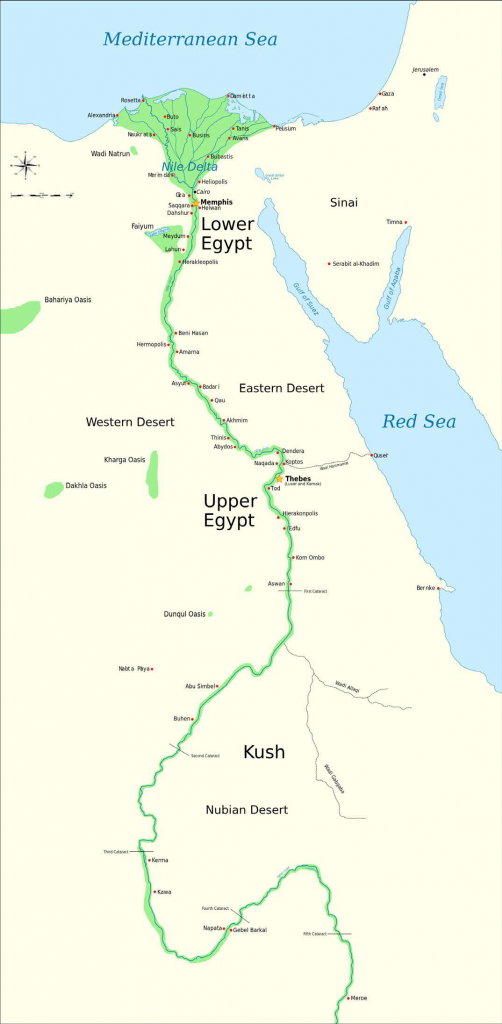
While scholars working over the past several decades have used artwork, archeology, and the surviving legal documents to draw conclusions about women’s roles in ancient Egypt, there is much ongoing debate about the prevalence of slavery within this society. Part of the disagreement stems from how various scholars define slavery. There is also great uncertainty about the number of slaves within the Egyptian population. The emerging consensus suggests that Egyptians increasingly used slaves from the Middle Kingdom onward. The majority of the slaves in these later dynasties were either prisoners of war or slaves brought from Asia. Slaves performed many tasks. For example, they labored in agricultural fields, served in the army, worked in construction, helped their merchant owners in shops, and were domestic servants for the Egyptian elite. Slaves were branded and, if possible, would be captured and returned to their masters if they tried to escape. Some masters undoubtedly abused their slaves, though the image of thousands of slaves sacrificed to be buried with pharaohs incorrectly depicts dynastic Egypt. Manumission (freeing a slave) was seemingly not very common, but if they were freed, former slaves were not stigmatized; instead, they were considered part of the general free population. These new scholarly conclusions about the relatively small numbers of slaves in Egypt, especially during the Old Kingdom, have impacted our understanding of how pyramids, tombs, and temples were constructed during dynastic Egypt.
The Old Kingdom saw pharaohs harness their influence to build pyramids to emphasize their relationship to the divine and facilitate their ascent to the gods after their earthly deaths. Pyramids, with their distinctive shape, which you can see in Figure 2.9, contained tombs for the pharaohs and their wives. They were marvels of engineering, built on a massive scale to honor the pharaohs and usher them into the afterlife. Pharaohs were mummified to preserve their bodies and were buried with everything considered necessary for the afterlife, including furniture, jewelry, makeup, pottery, food, wine, clothing, and sometimes even pets. The most recognizable pyramids from the Old Kingdom are the three pyramids at the Giza complex, which were built for a father (Egyptian pharaoh Khufu), and his son and grandson, who all ruled during the fourth dynasty.
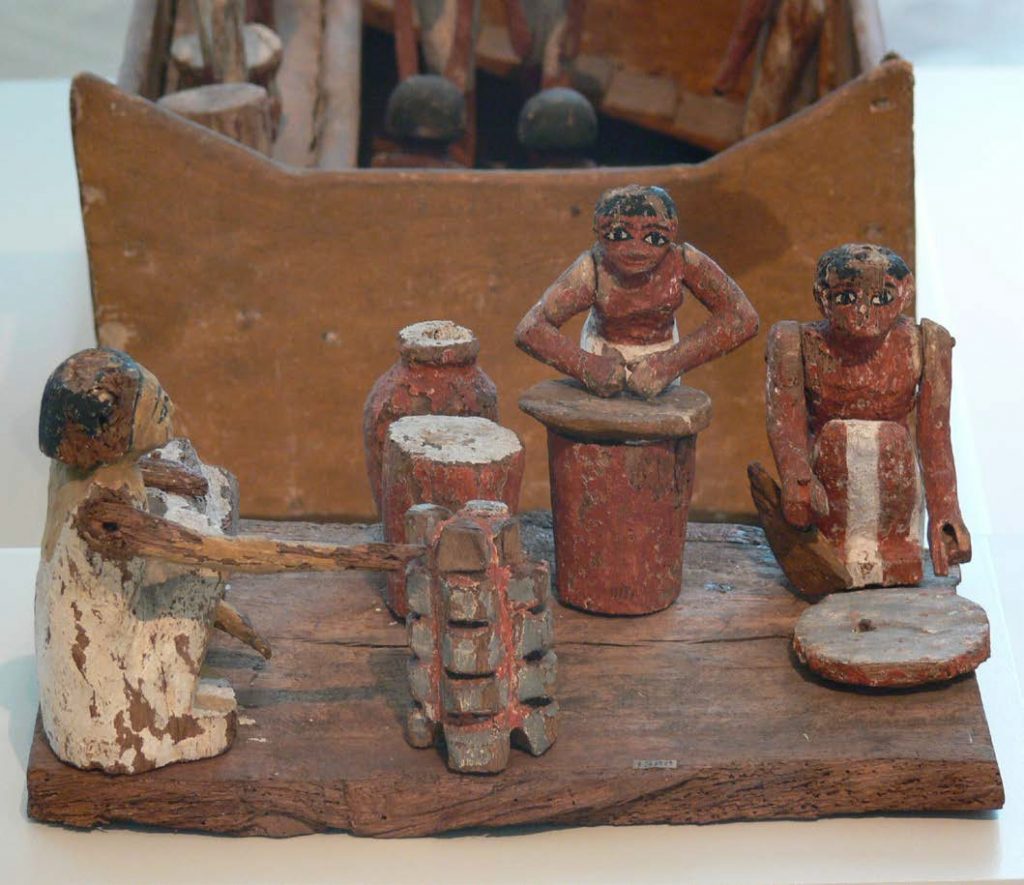
The Great Pyramid of Giza, built for Pharaoh Khufu, is the largest of the three pyramids. Still largely intact today, it was the largest building in the world until the twentieth century. Over 500 feet high, it covered an area of 200 square yards, and was built with over 600 tons of limestone. Recent studies on the construction of the pyramids have put much more emphasis on the roles of skilled craftsmen—who might work at multiple pyramid sites over the course of their lifetimes—and rotating groups of unskilled workers than on slaves. These studies suggest that skilled craftsmen and local labor forces of Egyptians were the primary builders of the pyramids, including the Great Pyramid of Giza. The Great Pyramid of Giza took an estimated 20 years to construct and employed skilled stonemasons, architects, artists, and craftsmen, in addition to the thousands of unskilled laborers who did the heavy moving and lifting. The construction of the Great Pyramid of Giza was an enormous, expensive feat. The pyramid stands as testimony to the increased social differentiation, the great power and wealth of the Egyptian pharaohs, and the significance of beliefs in the afterlife during the Old Kingdom.
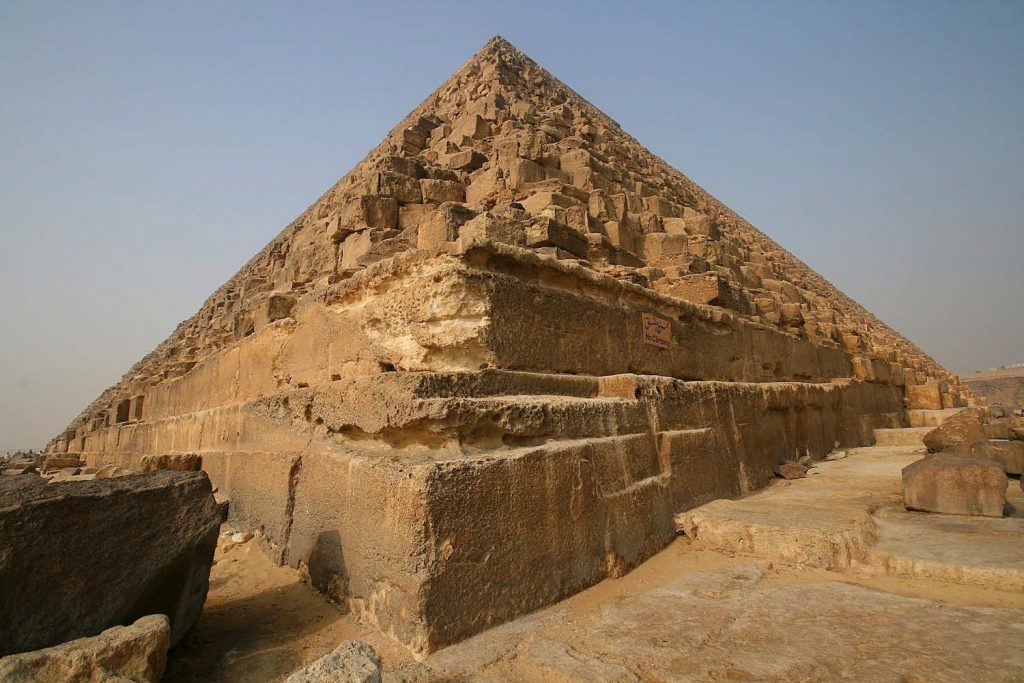
In addition to the construction of pyramids, the Old Kingdom saw increased trade and remained a relatively peaceful period. The pharaoh’s government controlled trade, with Egypt exporting grain and gold (the latter from Nubia to the south) and importing timber, spices, ivory, and other luxury goods. During the Old Kingdom, Egypt did not have a standing army and faced few foreign military threats. Lasting almost 400 years, the Old Kingdom saw the extension of the pharaoh’s power, especially through the government’s ability to harness labor and control trade. However, the power of the pharaohs began to wane in the fifth dynasty of the Old Kingdom.
Continuing environmental change that led to droughts and famine, coupled with the huge expense of building pyramids likely impoverished pharaohs in the last centuries of the Old Kingdom. Additionally, the governors known as nomes, who administered Egypt’s 42 provinces from the fifth dynasty onward, became more independent and took over functions that had been overseen by the state. As an added blow, the pharaohs lost control of trade. While dynastic leaders still referred to themselves as pharaohs, they lacked central authority over a unified Egypt by 2180 BCE.
Following the decentralized First Intermediate Period of roughly 150 years, Pharaoh Mentohotep II reunified Egypt to found the Middle Kingdom. The Middle Kingdom saw the reorganization of the state’s bureaucratic apparatus to control the nomes. To further strengthen their authority, the pharaohs also moved their capital from the Old Kingdom capital of Thebes south to Lisht, halfway between Upper and Lower Egypt. With military expeditions, they extended the boundaries of the state north to Lebanon and south to the second cataract of the Nile into a region known as Nubia. With this extension of territory, Egypt had access to more trade goods, and the organization of trade shifted so that professional merchants took a leading role in developing new trade routes. These professional merchants paid taxes to the state, supporting further consolidation of power by the pharaohs and also infrastructural improvements like irrigation. During the Middle Kingdom, the pharaohs focused less on the building of massive pyramids and more on administrative reorganization, military expeditions, and the state’s infrastructural repair. Disputes over succession and ineffectual rulers led into the Second Intermediate Period. Most notably, Egypt was invaded from both the north and the south during this period. The Hyksos invaded from the north in 1670 BCE. They brought bronze and horse-drawn chariots, which allowed them to conquer parts of Lower Egypt and establish their own kingdom, one lasting about 100 years in the Nile Delta region. From the south, the Kingdom of Kush, based in Nubia, invaded and temporarily established control over Upper Egypt to Aswan. Thus, foreign rulers dominated much of Egypt during the Second Intermediate Period.
The New Kingdom of reunified Egypt that began in 1530 BCE saw an era of Egyptian imperialism, changes in the burial practices of pharaohs, and the emergence of a brief period of state-sponsored monotheism under the Pharaoh Akhenaten. In 1530 BCE, the pharaoh who became known as Ahmose the Liberator (Ahmose I) defeated the Hyksos and continued sweeping up along the Eastern Mediterranean. By 1500 BCE, the Egyptian army had also pushed into Nubia, taking Kush southward to the fourth cataract of the Nile River (see Map 2.8). As pharaohs following Ahmose I continued Egypt’s expansion, the Imperial Egyptian army ran successful campaigns in Palestine and Syria, along the Eastern Mediterranean. Furthermore, by expanding into Kush, Egypt controlled trade routes into Sub-Saharan Africa. Adopting the Hyksos’ chariot military and metal technologies contributed to the Egyptian ability to strengthen its military. Egypt maintained a large standing army and built an expansive empire during the New Kingdom.
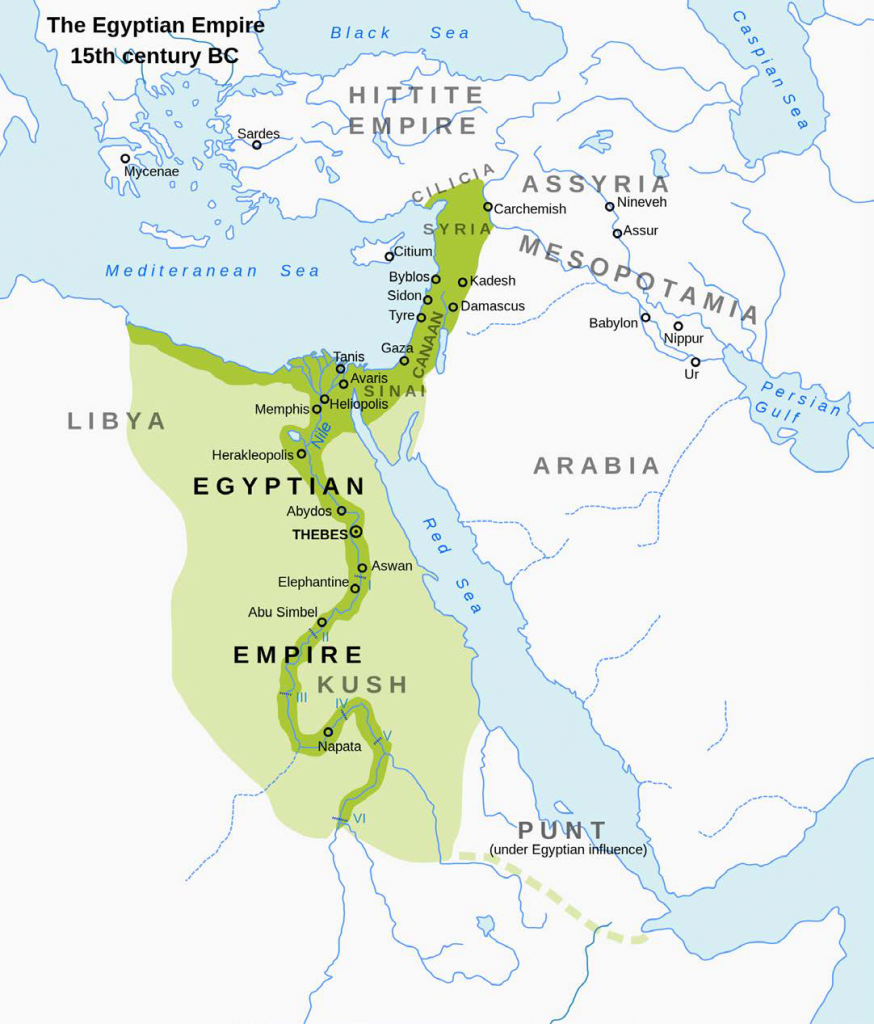
Egypt saw many other developments during the New Kingdom, especially when it came to burial practices and religion. During the New Kingdom, pharaohs and Egyptian elites used the Valley of Kings, located across the Nile River from Thebes, as their preferred burial site. They desired tombs that were hidden away and safe from tomb robbers. Therefore, instead of pyramids, they favored huge stone tombs built into the mountains of the Valley of the Kings. Nearly all of the tombs in the Valley of Kings were raided, so the fears of the pharaohs were well founded. Tomb raiding was even common during dynastic Egypt. King Tutankhamen’s tomb has become one familiar exception. His tomb fared unusually well over the millennia, and King Tutankhamen’s image is well known to us because his tomb was found mostly intact in 1922.
Throughout dynastic Egypt, much continuity existed in religious beliefs, causing scholars to characterize Egyptian society as conservative, meaning that Egyptians shied away from change. In general, Egyptian religious beliefs emphasized unity and harmony. Throughout the dynastic period, Egyptians thought that the soul contained distinct parts. They believed that one part, the ka, was a person’s lifeforce and that it separated from the body after death. The Egyptians carried out their elaborate preservation of mummies and made small tomb statues to house their ka after death. The ba, another part of the soul, was the unique character of the individual, which could move between the worlds of the living and the dead. They believed that after death, if rituals were carried out correctly, their ka and ba would reunite to reanimate their akh, or spirit. If they observed the proper rituals and successfully passed through Final Judgment (where they recited the 42 “Negative Confessions” and the god Osiris weighed their hearts against a feather), Egyptians believed that their resurrected spirit, their akh, would enter the afterlife. In contrast to Mesopotamian society, Egyptians conceptualized the afterlife as pleasant. In the afterlife, they expected to find a place with blue skies, agreeable weather, and familiar objects and people. They also expected to complete many of the everyday tasks, such as farming, and enjoy many of the same recognizable pastimes. Throughout the centuries, the Egyptians conceptualized the afterlife as a comfortable mirror image of life.
One change that occurred over time was the “democratization of the afterlife.” As time progressed through the Middle Kingdom and into the New Kingdom, more and more people aspired to an afterlife. No longer was an afterlife seen as possible for only the pharaoh and the elite of society. Instead, just about all sectors of society expected access, as evident in the increased use of funeral texts, like the Book of the Dead. People of varying means would slip papyrus with spells or prayers from the Book of the Dead (or a similar text) into coffins and burial chambers. They intended these spells to help their deceased loved ones make it safely through the underworld into the pleasant afterlife. Conceptualizations of the afterlife consistently emphasized its familiarity and beauty, while more people looked forward to this continued existence after their earthly deaths.

As they developed religious doctrine and came into contact with new deities, Egyptians integrated new gods and goddesses into their religious beliefs. Like ancient Mesopotamians, Egyptians were polytheistic. Some of the roles and back-stories of the deities did change over time; nevertheless, over the millennia they remained quite consistent. For example, Re, Osiris, Horus, and Isis, just to name a few deities in the Egyptian pantheon, stayed significant throughout dynastic Egypt. Re was the sun god, Osiris was the god of the afterworld, who also controlled nature’s cycles (like the all important flooding of the Nile), Horus became a god of war and protection, and Isis was a goddess associated with healing and motherhood. During the Middle Kingdom, Amun, initially a patron saint of the city of Thebes and later recognized as the father of the pharaoh, was combined with Re, the sun god, to become Amun-Re the supreme god of the Egyptian pantheon. Amun-Re retained this place at the top of the Egyptian pantheon through most of the New Kingdom. One major exception occurred during the reign of Pharaoh Akhenaten.
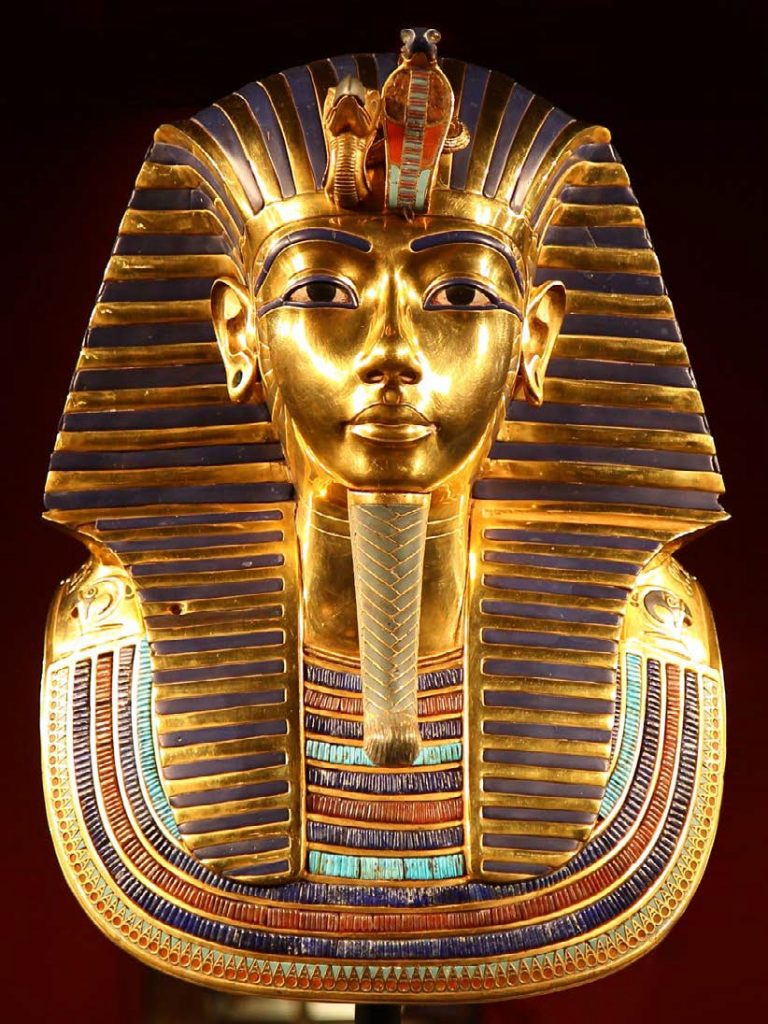
Pharaoh Akhenaten started what is known as the Amarna Period. The Amarna Period, which lasted from approximately 1350 to 1325 BCE, stands out for its state-sponsored monotheism. Akhenaten introduced radical changes to Egyptian society, moving the capital to Tell el Amarna, a new settlement in the middle of the desert that was devoted to the worship of Aten and the recognition of the pharaoh’s superiority over everyone else. Aten, who had been one of many deities worshipped during the Middle Kingdom, was elevated to the creator god associated with sunlight, the foundation of all life. The “Great Hymn to Aten” explains the god Aten’s association with the sun as, like the sun, his “rays embraced the lands” of Egypt.[1] Akhenaten had the Great Temple of Aten built in the middle of the new capital, and, unlike previous temples, this one had no roof and was open to sunlight. Akhenaten further modified Egyptian religious doctrine to identify himself as the son of Aten. According to the new religious ideology, Akhenaten alone was able to ensure access to the afterlife and communicate with Aten, the sole god. To reinforce Aten’s singularity, Akhenaten withdrew financial support from temples dedicated to other deities and defaced the temples dedicated to Amun, who had previously been the most dominant Egyptian deity. The prominence of Aten and Akhenaten’s exclusive access to him define the Amarna Period.
Why did Akhenaten introduce these radical changes? At least in part, Akhenaten wanted to break with the priests in Thebes who controlled the temples dedicated to Amun because he believed that these priests had become too powerful. Additionally, by taking on the role of the son of Aten and regulating entry into the afterlife, Akhenaten certainly attempted to reformulate beliefs to emphasize his own importance.
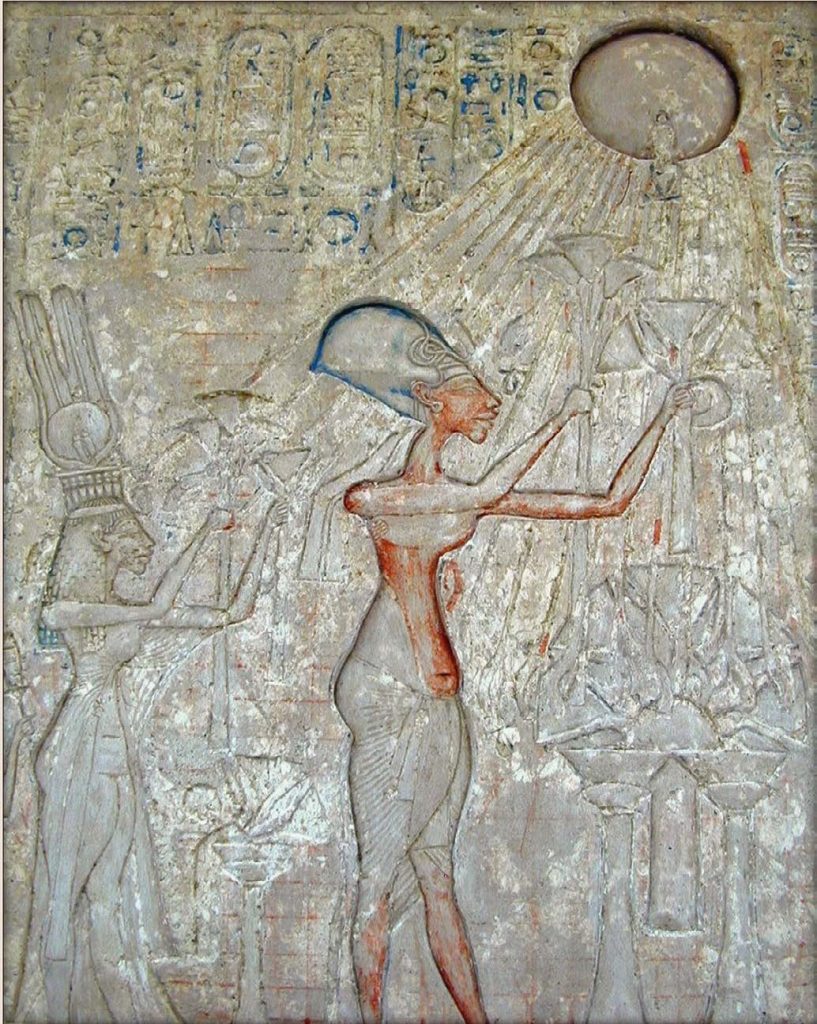
Akhenaten’s radical changes were likely troubling for most of the Egyptian population. They had previously found comfort in their access to deities and their regular religious rituals. The worship of Aten as the only Egyptian god did not last more than a couple of decades, floundering after the death of Akhenaten. Pharaohs who ruled from 1323 BCE onward tried not only to erase the religious legacies of the Amarna Period, but also to destroy the capital at Tell el Amarna and remove Akhenaten from the historical record. Archaeologists have not found Akhenaten’s tomb or burial place. Scholars continue a long-standing debate about how this brief period of Egyptian monotheism relates (if at all) to the monotheism of the Israelites. Despite such uncertainties, study of the Amarna period does indicate that Egyptians in the fourteenth century BCE saw the fleeting appearance of religious ideology that identified Aten as the singular god.
Some of the strongest rulers of the New Kingdom, including Ramses I and Ramses II, came to power after the Amarna Period. These pharaohs expanded Egypt’s centralized administration and its control over foreign territories. However, by the twelfth century BCE, weaker rulers, foreign invasions, and the loss of territory in Nubia and Palestine indicated the imminent collapse of the New Kingdom. In the Late Period that followed (c. 1040 to 332 BCE), the Kingdom of Kush, based in Nubia, invaded and briefly ruled Egypt until the Assyrians conquered Thebes, establishing their own rule over Lower Egypt. Egyptian internal revolts and the conquest by Nubia and the Assyrian Empire left Egypt susceptible to invasion by the Persians and then eventually the 332 BCE invasion of Alexander the Great. The ancient Egyptians made numerous contributions to World History. We remember them for mummification, their pharaohs, and the pyramids. Certainly, in this era, Egypt stands out for its ability to produce agricultural surpluses that supported the elites, priests, and skilled craftspeople. While we tend to focus on the bureaucratic, religious, and artistic contributions of these classes, all Egyptians played crucial roles in creating and maintaining this sophisticated civilization. Additionally, the innovations of Egyptians, such as their stone-carving techniques, hieroglyphics, the use of papyrus, their knowledge of the length of a solar year, and their construction methods, influenced the ancient world and still inspire awe. Overall, the ancient Egyptians created a vibrant civilization, while they also found comfort in the familiar and traditional.
- “The Great Hymn to Aten.” http://web.archive.org/web/19990221040703/http://puffin.creighton.edu/theo/simkins/tx/ Aten.html ↵

